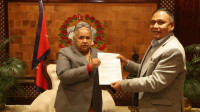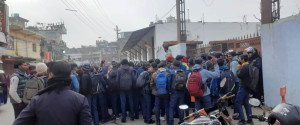National
A normal monsoon this year could boost agricultural output, if only farmers weren’t under lockdown
A labour shortage due to the Covid-19 pandemic and a potential shortage of chemical fertiliser could offset any potential gains from the monsoon, say economists..jpg&w=900&height=601)
Sangam Prasain & Chandan Kumar Mandal
Nepal is looking at a favourable ‘normal’ monsoon season this year, which would, in normal times, bode well for the country’s paddy plantation. But these are extraordinary circumstances and thousands of farmers remain indoors under lockdown due to the Covid-19 pandemic.
The rice plantation period normally begins in early May in the hills and June in the Tarai, the country's food basket. The monsoon usually begins on June 10 and lasts till September 23. Nearly three-quarters of annual rainfall in the country occurs during the monsoon and sustains the livelihood of 66 percent of the population that is dependent on agriculture.
But as tens of thousands of farmers have been under lockdown since March 24, there are fears that the boost a normal monsoon could provide to paddy plantation this year could be lost.
The sixteenth session of the South Asian Climate Outlook Forum, a consortium of meteorologists and hydrological experts from South Asia, has predicted a normal monsoon over South Asia this summer.
“Broadly speaking, the SASCOF-16 has predicted that Nepal can expect a normal monsoon this year,” said Indira Kadel, senior divisional meteorologist and chief of the climate analysis section at the Department of Hydrology and Meteorology.
“On a countrywide scale, rainfall is predicted to be normal, but if we look at the prediction minutely, it can swing between near-normal and below-normal, as the probability is between 40-50 percent,” she said. “But the chances of a below-normal monsoon are low.”
The weather and climate, as well as the agriculture of Nepal and the entire South Asian region, is dominated by the monsoon, which supplies nearly 70-80 percent of annual rainfall.
According to Kadel, a normal monsoon means favourable conditions for agricultural production, as rainfall is directly linked with the country’s agriculture and in turn, the economy.
“Farmers can go ahead with normal crops this monsoon. When the monsoon is below normal, they have had to go for paddy varieties prescribed for a drought-like situation, or flood-tolerant varieties in case of excessive rain during an above-normal rainfall,” said Kadel. “Normal monsoon also means fewer natural disasters, but that doesn’t mean there will not be any extreme events.”
Normal monsoon boosts farm output and farmers’ incomes, and helps keep inflation in check. A normal monsoon also has positive impacts on hydropower, irrigation, drinking water and groundwater recharge.
The country has witnessed a normal monsoon for three consecutive years, propelling the country to record growth rates of over six percent for three years in a row, driven largely by the agricultural sector.
In the fiscal year 2016-17, the country’s economy expanded by 7.74 percent, the highest since 1993-94.
An above-normal monsoon recorded in 2016-17 helped Nepal secure the biggest paddy harvest, which jumped 21.66 percent to 5.23 million tonnes, bucking the trend of two consecutive years of falling harvests triggered by drought.
The economy grew by 6.3 percent in the following year 2017-18, according to the Central Bureau of Statistics. In 2017-18, Nepal’s paddy output totalled 5.15 million tonnes, down 1.49 percent from the 2016-17 bumper harvest.
The country's economy grew by 7.1 percent in 2018-19.
But there are worries that the benefits of a normal monsoon could be lost, with a looming shortage of chemical fertilisers as factories across the world remain closed.
A shortage of workers could affect the delivery of chemical fertilisers for the upcoming paddy plantation period, according to Bishnu Prasad Pokhrel, spokesperson for the Agriculture Inputs Company, the state-run supplier of subsidised fertiliser.
“We have enough stock of diammonium phosphate, the most widely used phosphorus fertiliser, but there could be a shortage of urea if suppliers fail to deliver it on time,” said Pokhrel.
According to Pokhrel, the company currently has 70,000 tonnes of chemical fertiliser, which includes both DAP and urea, in stock, but paddy plantation during the June-August period requires more than 150,000 tonnes.
The government has increased the budget for subsidised chemical fertiliser from Rs5 billion to Rs9 billion this fiscal year to ensure timely supply and sufficient quantity, but given the Covid-19 pandemic and the subsequent lockdown, this support might not materialise.
According to economist Chandan Sapkota, the disruption to the labour market and a likely lack of agricultural inputs, particularly imported chemical fertiliser, are definitely going to affect summer crops, particularly paddy.
"The negative effect from these will more than offset the potential gains from a normal monsoon,” said Sapkota. “So food prices pressures are likely to be high."




 5.47°C Kathmandu
5.47°C Kathmandu









%20(1).jpg&w=300&height=200)





